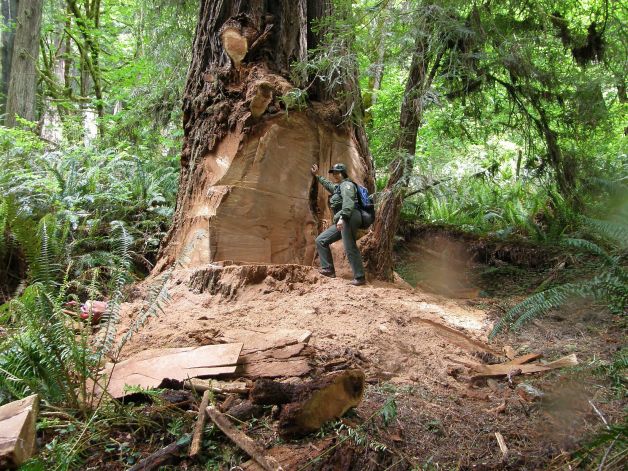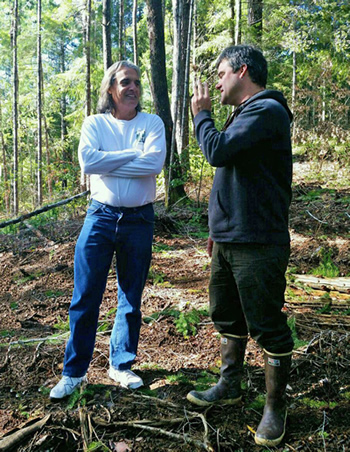MEDIA RESOURCES THAT SUPPORT OUT VISION TO COMBINE ECONOMY WITH ECOLOGY WHILE RESTORING THE FORESTS
By: DR. HANS BURKHARDT
This article first appeared in the International Journal of Ecoforestry in the spring of 1996. It is excerpted and reprinted on our website with permission from the author, Mr. Hans Burkhardt, Ph.D. While he was alive, Mr. Burkhardt was closely affiliated with OGA and his research is a guiding principle of OGA's field work.
For anyone who is at all aware of our planetary ecological condition, it is starkly clear that our society must stop its current suicidal mode of action, and we must find more sustainable ways to live and do business. While it is critical that we make sweeping changes in several areas, such as population reduction, over-consumption and fossil fuel use, my purpose is to focus on one critical area - our relationship to the native forest resource.

November 23, 1997


Examples of poor forestry practices in the Redwoods:
The aerial shot on the right was taken in Central Mendocino County in the early 1990's on Louisiana Pacific lands showing extensive clear-cuts. The solid forestland in the top center is the Jackson State Forest.
The one on the left of the creek side with all the slash was taken very near the boundary with the Redwood National Park in the mid-1970's.

March 4, 2014

This May 21, 2013 photo provided by the National Park Service shows wildlife biologist Terry Hines standing next to a massive scar on an old growth redwood tree in the Redwood National and State Parks near Klamath, Calif., where poachers have cut off a burl to sell for decorative wood. The park recently took the unusual step of closing at night a 10-mile road through a section of the park to deter thieves. (AP Photo/Redwood National and State Parks, Laura Denn)
Authorities say unemployment and drug addiction have spurred an increase in the destructive practice of cutting off the knobby growths at the base of ancient redwood trees to make decorative pieces like lacey-grained coffee tables and wall clocks.


February 11, 2015
By: Will Parrish

The world's largest remaining contiguous stand of old-growth redwood forest resides in Humboldt Redwoods State Park in Northern California. On the park's northwestern flank, six people gathered last May to oppose a logging venture on adjacent private property. For four days, the activists shadowed the loggers and their supervising forester, as well as three Humboldt County sheriff's deputies who were keeping a watchful eye on the forest defenders in case they edged over the park boundary.

Panoramic Shot of Sanctuary Forest
The Sanctuary Forest is a small but important link in the restoration of the Mattole Watershed in Humboldt County. Located right off the main road, a very public process that has taken many years is now nearing completion.
With a lot of public input, a final plan was implemented to thin the stand of excess younger trees, perform extensive road improvements to lower sedimentation, add structures (boulders, large woody debris) to build habitat in the river for salmon and, at the same time, all the existing ancient and large trees have been protected. The plan is to possibly reenter the stand one more time in 2 or 3 decades to complete the spacing improvement on the remaining smaller trees and then to leave the stand untouched in perpetuity as an example of excellent restoration forestry.

January 27, 2020
By:
Galina Churkina, Alan Organschi, Christopher P. O. Reyer, Andrew Ruff, Kira Vinke, Zhu Liu, Barbara K. Reck, T. E. Graedel, Hans Joachim Schellnhuber (2020): Buildings as a global carbon sink. Nature Sustainability
[DOI:10.1038/s41893-019-0462-4]
A material revolution replacing cement and steel in urban construction by wood can have double benefits for climate stabilization, a new study shows. First, it can avoid greenhouse gas emissions from cement and steel production. Second, it can turn buildings into a carbon sink as they store the CO2 taken up from the air by trees that are harvested and used as engineered timber. However while the required amount of timber harvest is available in theory, such an upscaling would clearly need most careful, sustainable forest management and governance, the international team of authors stresses.

December 13, 2023

In a cavernous theater lit up with the green shapes of camels and palms at COP28 in Dubai, ecologist Thomas Crowther, former chief scientific adviser for the United Nations’ Trillion Trees Campaign, was doing something he never would have expected a few years ago: begging environmental ministers to stop planting so many trees.

April 4, 2024

Despite major progress in protecting vast tracts of rainforest, the world failed again last year to significantly slow the pace of global forest destruction, according to a report issued on Thursday. Record wildfires in Canada and expanding agriculture elsewhere offset big gains in forest protection in Brazil and Colombia, the report found.
The annual survey by the World Resources Institute, a research organization, found that the world lost 9.1 million acres of primary tropical forest in 2023, equivalent to an area almost the size of Switzerland, about 9 percent less than the year before. But the improvement failed to put the world on course to halt all forest loss by 2030, a commitment made by 145 nations at a global climate talks in Glasgow in 2021 and reaffirmed by all countries last year.




